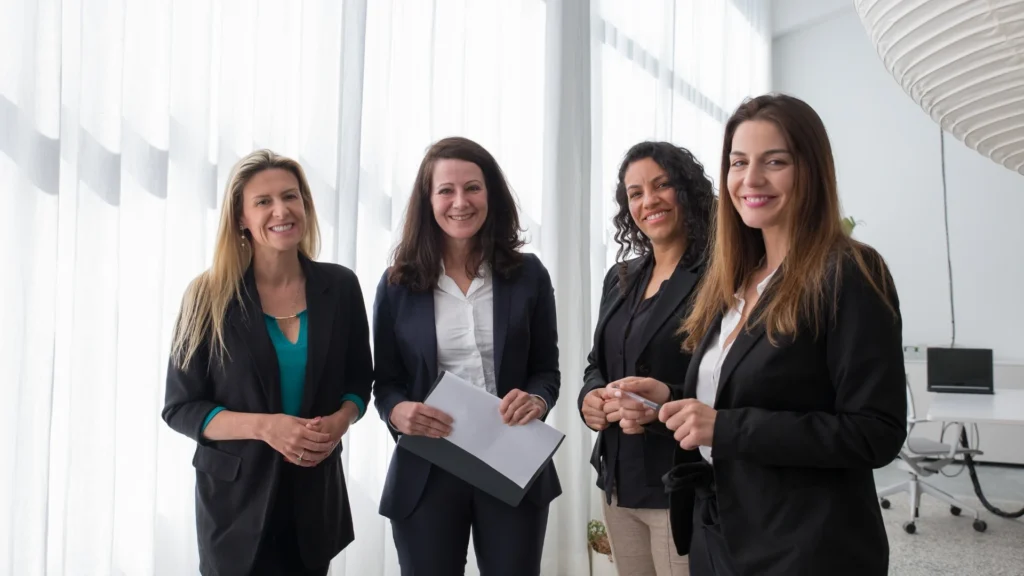Elevate your professional image with stylish interview outfits for women. Make a lasting impression in your next job interview.
Discover the best interview attire tips for women to nail your next job interview. Dress for success and stand out from the crowd.
Find expert advice on interview attire for women. Dress confidently and professionally to land your dream job effortlessly.

Introduction
Dressing appropriately for a job interview is essential as it not only reflects your professionalism but also plays a crucial role in creating a positive first impression.
For women, choosing the right interview attire can be both empowering and challenging.
This article aims to provide comprehensive guidance on selecting the perfect interview outfit that aligns with company culture and boosts confidence.
Understanding the Importance of Interview Attire
First impressions matter significantly in interviews. Your attire communicates your respect for the opportunity and your understanding of the company’s culture.
Dressing appropriately showcases your attention to detail and professionalism before you even utter a word.
Researching Company Culture
Before selecting your interview outfit, research the company’s culture. Are they corporate and traditional or more relaxed and creative?
This understanding will guide your clothing choices to ensure they resonate with the workplace environment.
General Guidelines for Interview Attire
Suitable Outfits for Different Industries
Different industries have varying expectations for interview attire. For corporate jobs like banking or law, opt for formal business wear.
In creative or startup environments, you can showcase more individuality with stylish yet professional outfits.
Dressing for Corporate Jobs
For corporate interviews, a tailored suit in neutral colors like black, navy, or gray is ideal. Pair it with a crisp blouse and closed-toe heels. Avoid overly trendy or revealing clothing.
Dressing for Creative or Startup Environments
In more creative settings, you can incorporate some personality into your outfit. Consider a stylish dress with a blazer or tailored pants with a colorful blouse and statement accessories.
Key Components of Women’s Interview Attire
Tops and Blouses
Choose tops that are conservative and well-fitted. Opt for solid colors or subtle patterns that complement your overall look without being distracting.
Bottoms (Skirts vs. Pants)
Select bottoms that are comfortable and professional. A knee-length pencil skirt or tailored pants are both excellent choices.
Jackets and Blazers
A well-fitted blazer can instantly elevate your look. Stick to classic styles and neutral colors that enhance your silhouette.
Footwear and Accessories
Closed-toe pumps or flats are suitable for most interviews. Keep jewelry and accessories minimal and tasteful.
Accessories and Their Impact on Your Interview Look
The choice of accessories can significantly influence your overall interview outfit. Opt for elegant and understated accessories that complement your attire rather than overpowering it.
Classic pieces like stud earrings, a simple watch, or a professional handbag can enhance your appearance without distracting from your qualifications and personality.

Dressing Tips for Different Body Types
Every woman has a unique body shape, and it’s essential to choose interview attire that flatters your figure.
Tailored clothing that fits well can enhance your silhouette and boost confidence.
For example, A-line skirts can be flattering for pear-shaped figures, while structured blazers can create a streamlined look for broader shoulders.
Experiment with different styles to discover what suits you best.
This is valuable advice on infusing personal style into professional attire and selecting interview outfits that complement different body types.
Practical Tips for Dressing Comfortably
Choose fabrics that are breathable and comfortable. Test your outfit beforehand to ensure ease of movement, especially if you have to travel for the interview.
Here are also some points that should be remembered for interviewing:
Color Choices and Professionalism
Stick to neutral colors like black, navy, gray, or beige for a polished and professional appearance. Bright colors can be used sparingly to add a touch of personality.
Grooming and Personal Hygiene
Ensure that your hair is neat and styled appropriately. Keep makeup natural and understated. Pay attention to personal hygiene and avoid strong perfumes.
Avoiding Common Fashion Mistakes
Avoid wearing overly casual clothing, excessive jewelry, or clothes that are too tight or revealing. Dress conservatively to convey professionalism.
Special Considerations for Virtual Interviews
For virtual interviews, ensure that your outfit looks professional on camera. Opt for solid colors and avoid busy patterns that might appear distracting.
Cultural Sensitivity in Dressing
Respect cultural norms when selecting your interview attire, especially if interviewing for positions in diverse environments.
Budget-Friendly Interview Outfit Ideas
You don’t need to break the bank to dress impressively for an interview. Explore thrift stores or sales for quality professional attire on a budget.
Final Touches and Confidence Boosters
Add finishing touches like a professional bag or portfolio and a genuine smile. Confidence is key to making a lasting impression.
Dressing for Success: Confidence and Body Language
Your attire plays a significant role in how you feel and present yourself during interviews.
- Choose clothing that makes you feel confident and comfortable.
- Stand tall, make eye contact, and use positive body language to convey professionalism and enthusiasm.
Remember, confidence in your appearance can boost your overall performance during the interview.
These insights into dressing appropriately for virtual interviews and the importance of projecting confidence through your attire and body language.
Understanding specific dress codes mentioned in interview invitations is crucial.
Terms like “business formal,” “business casual,” or “smart casual” carry distinct expectations.
- Business formal typically entails suits or tailored dresses.
- Business casual allows more flexibility with separates.
- Smart casual leans towards polished yet relaxed outfits, ideal for creative industries.
Dressing for Different Levels of Formality
Understanding the level of formality required for different types of interviews is crucial.
For example, if you’re interviewing for an executive role, opt for a sophisticated power suit in classic colors like navy or charcoal.
For entry-level positions or more casual industries, a well-fitted dress or blouse with tailored pants can strike the right balance between professionalism and approachability.
Incorporating Personal Style While Maintaining Professionalism
While it’s important to dress appropriately for interviews, don’t be afraid to showcase your personal style within professional boundaries.
Incorporate subtle elements of your unique style, such as a favorite accessory or a touch of color, to add personality to your outfit.
Just ensure that your overall look remains polished and suitable for the interview environment.
Understanding Cultural Sensitivity in Dressing
In today’s diverse workplaces, it’s important to be culturally sensitive with your attire choices. If you’re interviewing for a company with a multicultural environment, research appropriate dress norms that respect various cultural backgrounds.
Avoid clothing that may inadvertently offend or misrepresent cultural traditions.
Bonus Tips for About Interview Attire for Women
Follow-Up Dress Etiquette
After the interview, continue to maintain a polished appearance if you’re invited for a second round or hired for the job. Dress appropriately for follow-up meetings or when interacting with potential colleagues.
Showing consistency in your attire reinforces your commitment and respect for the company’s expectations.
Adapting Attire for Panel Interviews
Panel interviews involve multiple interviewers, often from different departments. Dressing conservatively is advisable, but also consider incorporating subtle elements that reflect your adaptability and style.
A well-chosen accessory or a touch of color can subtly convey confidence and professionalism in a panel setting.
Dressing for Virtual Interviews
With the rise of remote job interviews, it’s essential to dress appropriately for virtual meetings. Choose attire that looks professional on camera, focusing on the top half of your outfit since that’s what will be visible.
Opt for solid colors and avoid busy patterns or distracting accessories. Ensure good lighting and a tidy background to present yourself in the best possible light.
Dressing for Video Interviews
Video interviews require specific considerations for attire. Choose solid, neutral colors that contrast well with your background.
Avoid overly bright colors or busy patterns that can be distracting on camera.
Ensure your outfit is comfortable for sitting and standing, and test your appearance on camera beforehand to make any necessary adjustments.
Dressing for Different Seasons
Consider the weather when choosing your interview outfit. In warmer months, opt for lightweight fabrics like cotton or linen to stay cool and comfortable.
For colder seasons, layering with a tailored coat or chic scarf can add warmth without compromising professionalism.
FAQs About Interview Attire for Women
Q1: What should I wear for a business casual interview?
A: For business casual interviews, opt for smart separates like tailored pants or a skirt with a blouse or sweater. Avoid jeans and overly casual clothing.
Q2: Can I wear accessories to an interview?
A: Yes, but keep them minimal and tasteful. Opt for classic pieces like stud earrings or a simple necklace.
Q3: Should I wear makeup for an interview?
A: Makeup should be natural and understated. Enhance your features without appearing too glamorous.
Q4: Is it okay to wear flats to an interview?
A: Closed-toe flats are acceptable, especially if you’re more comfortable in them than heels. Choose polished and professional-looking flats.
Q5: How can I ensure my outfit is appropriate for a virtual interview?
A: Test your outfit in front of a camera to see how it looks on screen. Stick to solid colors and avoid distracting patterns.
Read More:
- Streamlining Your Hiring Process: The Power of Interview Scheduling Software
- Dressing for Success: The Ultimate Guide to Interview Outfits for Women
- Klaviyo Interview: Nailing Your Opportunity
Conclusion About Interview Attire for Women
Choosing the right interview attire is a strategic investment in your career. By aligning your outfit with the company’s culture and presenting yourself professionally, you set yourself up for success.
In conclusion, choosing the right interview attire for a woman is crucial for making a positive first impression. Remember to opt for professional and polished pieces that align with the company’s dress code.
By dressing appropriately and confidently, you can set yourself up for success and show your potential employer that you are serious about the opportunity. Good luck with your next interview!